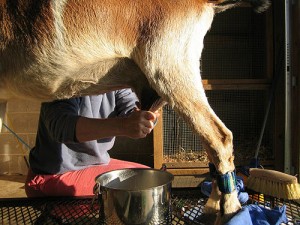Okay, you’ve done it. You went out and brought a beautiful little goat or cow home, and you’ve fixed up an area for her to live happily. You’ve created a milking station and are all set to enjoy the great benefits of having fresh milk on your little homestead. The next morning you trudge out to the garage, shed, or barn where it’s all waiting for you, and stare little Bessie in the eyes. She looks at you apprehensively but follows you to the milk stand, hops up, and begins to dutifully eat the grain you placed there for her.
 That’s when you sit down on the stool next to her and reach below to grab a teat, and… nothing. Where is it? Where’s all that great milk that you can drink and make cheese with? Slowly you realize there may be something missing. Something you haven’t learned yet. You need to understand the milk cycle.
That’s when you sit down on the stool next to her and reach below to grab a teat, and… nothing. Where is it? Where’s all that great milk that you can drink and make cheese with? Slowly you realize there may be something missing. Something you haven’t learned yet. You need to understand the milk cycle.
Goats and cows are amazing animals, and they produce a large amount of milk, but it isn’t in their nature to produce that milk for other people to drink. Goats and cows produce milk to feed their young. That means you absolutely HAVE to breed your goat or cow in order to get milk. It is a good idea to buy a goat or cow that is either already fresh (a term that means having just given birth) and has a baby at their side, or is pregnant and will give birth soon.
If you bought a fresh doe (female goat) or cow, then you really did get delicious fresh milk when you reached under and grabbed the teat. If you didn’t, you either have to wait for that doe or cow to give birth, or find a way to breed them. No matter how you choose to do that—artificial insemination, natural breeding by taking her to a buck or bull, or having your own buck or bull to breed them to, you’ll have to wait until she gives birth to get the milk.
To Separate or Not to Separate
Once your girl gives birth, you’ll have to decide whether you want to leave her baby/babies with her and share the milk, or if you want to bottle-feed the babies. There are good arguments for both choices, and it really comes down to personal preferences.
If you leave the baby or babies with the doe or cow, you will get a little less milk, but there is a more natural bond between mother and offspring, and the babies get as much milk as they need naturally, when they want it. If you separate the offspring, you’ll get a lot more milk. You’ll also get a lot more work because you’ll have to feed those kids or calves (unless you butcher them for meat at a very early age). There is a plus side to bottle feeding babies if you are keeping them as replacement or additional stock to milk and breed when they get older: you will form a much better bond with the baby, and as adults, they will be much easier to handle with less work than babies left with their mother.
The Natural Cycle
Even after breeding, waiting for the babies, and getting the fresh milk, you still have to realize there is a natural cycle to milk production. It won’t go on forever. It’s true that continuous, regular milking will prolong the normally predicted cycle, but there is an arc that will still occur. At some points you will be swimming in milk, and at others you will barely eek by, and then it will stop altogether until you breed again.
When your doe or cow freshens, the early milk is actually colostrum, which is a thick nutrient rich version of milk that isn’t very useful to your kitchen. There are some exotic dishes made with colostrum, but it is definitely an acquired taste. This period usually lasts about two weeks, and it is best to feed all of this directly to the babies. It is very important to them and will give them the best start.
If you are keeping the babies with their mom, it’s still a good idea to take her to the milking stand at milking times to get her used to the process and teach her to share her milk with you. If you are bottle-feeding the babies, it’s easy. Simply milk as usual, but feed the colostrum to the babies.
After the colostrum clears up, you are finally getting milk, but you may be a little disappointed at the amount. Remember that in nature your doe or cow is making milk to feed their babies, and newborn babies don’t need as much as older babies. As you continue to milk, the increased demand will trigger her body to create more to feed those hungry offspring of hers (of which you are now one).
Slowly the production will increase until at about three or four months fresh, you reach a peak in production. Depending on whether you have a goat or a cow, that can be ¾ gallon to two gallons per day. Different breeds of either species have different capacities. A Nubian gives a little less milk than a Saanen. Comparably, the Nubian would be like a Jersey cow, with less milk with a much higher fat content, and the Saanen would be the Holstein of the goat world, with lots of milk that has less fat content. All of the goat breeds have their own peculiarities and specialties.
Weighing In
The peak of milk production can last for a long time, and you may not notice the drop off at first. The best way to keep track of milk production is to weigh the milk after every milking. Any scale will do well for this, but a hanging milk scale is best and can be found at any farm store or online stores dedicated to goats or cows and milking. Remember to weigh the container you are using to gather the milk first, and then subtract that from the total weight when it’s full.
After a year to a year and a half, milk supplies naturally start dropping significantly. There are some unusual animals that will continue to milk for up to two years, but they are the exception rather than the rule.
Dairy Management
The most productive method of keeping your milk flowing is to breed regularly. That means having access to whatever means of breeding you are going to employ at least once a year. After you re-bred your doe or cow, you can still continue to milk them, but it is a good idea to taper off milking and help them “dry off” one to two months prior to freshening again.
Help for the Dry Months
There are several ways you can defeat the dry months. The first is to plan ahead and freeze some of your milk supply when the supply is at its best. The second is to have more than one dairy animal. Since both goats and cows are by nature herd animals, that makes the best sense anyway. If you have two dairy animals, you can stagger the breeding so that each is going through the normal milk cycle at different stages. When you do dry one off to prepare for giving birth, the other is still milking. Your supply will be smaller, but still existent.
It may take you a few cycles to perfect your methods, but it is well worth the effort. You’ll soon fall into the rhythm of the milking cycle and have plenty of delicious fresh milk for you and your family.
©2011 Off the Grid News
 Off The Grid News Better Ideas For Off The Grid Living
Off The Grid News Better Ideas For Off The Grid Living



